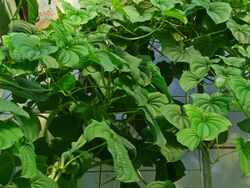Biology:Dioscorea esculenta
| Dioscorea esculenta | |
|---|---|

| |
| Scientific classification | |
| Kingdom: | Plantae |
| Clade: | Tracheophytes |
| Clade: | Angiosperms |
| Clade: | Monocots |
| Order: | Dioscoreales |
| Family: | Dioscoreaceae |
| Genus: | Dioscorea |
| Species: | D. esculenta
|
| Binomial name | |
| Dioscorea esculenta (Lour.) Burkill[1]
| |
Dioscorea esculenta, commonly known as the lesser yam, is a yam species native to Island Southeast Asia and introduced to Near Oceania and East Africa by early Austronesian voyagers. It is grown for their edible tubers, though it has smaller tubers than the more widely-cultivated Dioscorea alata and is usually spiny.[2]
Names
In Vietnam, it is called khoai từ or củ từ. It is used to make chè củ từ, also referred to as chè khoai từ. In Tagalog, it is known as tugi, while in Cebuano it is called apali. It is cultivated in Kerala, Goa, Konkan parts of Maharashtra India. In Malayalam, it is known as nana kizhangu or nheruvalli kizhangu or Cheru Kizhangu". In Goa it is called Kaate Kanaga (काटे कणगा ), It is a climber which needs support and goes coiling around the support.
History of cultivation
The lesser yam is the second most important yam crop among Austronesians. Like D. alata, it requires minimal processing, unlike the other more bitter yam species. However, it has smaller tubers than D. alata and is usually spiny. Like D. alata it was introduced to Madagascar and the Comoros by Austronesians, where it spread to the East African coast.[3][4][5] They are also a dominant crop in Near Oceania, However, it did not reach to the furthest islands in Polynesia, being absent in Hawaii and New Zealand.[6][7][8]
Starch grains identified to be from the lesser yam have been recovered from archaeological sites of the Lapita culture in Viti Levu, Fiji, dated to around 3,050 to 2,500 cal BP.[9] D. esculenta is believed to have been introduced by the Lapita culture into New Guinea, along with agricultural innovations like wet cultivation.[10][11] Traces of D. esculenta (along with D. alata, D. bulbifera, D. nummularia and D. pentaphylla) yams have also been identified from the Mé Auré Cave site in Moindou, New Caledonia, dated to around 2,700 to 1,800 BP.[12] Remains of D. esculenta have also been recovered from archaeological sites in Guam, dated to around 1031 CE.[13]
Taxonomy
Belonging to the genus Dioscorea, Dioscorea esculenta describes the plant's ability to produce edible roots.
Description
The plant's stems are round and thin, with big, black compound spines that are 2–4 cm long. The leaves are soft, heart-shaped, and 5–8 cm long and 6–8 cm wide.[14]
See also
- Domesticated plants and animals of Austronesia
- Yam production in Nigeria
References
- ↑ Gardens' Bulletin. Straits Settlements. Singapore 1:396. 1917. Plant Name Details for Dioscorea esculenta. 1. http://www.ipni.org:80/ipni/idPlantNameSearch.do?id=317946-1. Retrieved 24 September 2017.
- ↑ Andres, C.; AdeOluwa, O.O.; Bhullar, G.S. (2016). "Yam (Dioscorea spp.)". in Thomas, Brian; Murphy, Denis J.; Murray, Brian G.. Encyclopedia of Applied Plant Sciences (2nd ed.). Academic Press. pp. 435–441. ISBN 9780123948076. https://www.researchgate.net/publication/312231378.
- ↑ Blench, Roger (2010). "Evidence for the Austronesian Voyages in the Indian Ocean". in Anderson, Atholl; Barrett, James H.; Boyle, Katherine V.. The Global Origins and Development of Seafaring. McDonald Institute for Archaeological Research. pp. 239–248. ISBN 9781902937526. http://www.rogerblench.info/Archaeology/Indian%20Ocean/Austronesians%20in%20East%20Africa%20offprint.pdf.
- ↑ Beaujard, Philippe (August 2011). "The first migrants to Madagascar and their introduction of plants: linguistic and ethnological evidence". Azania: Archaeological Research in Africa 46 (2): 169–189. doi:10.1080/0067270X.2011.580142. https://halshs.archives-ouvertes.fr/halshs-00706173/file/Beaujard.azania2.pdf.
- ↑ Hoogervorst, Tom (2013). "If Only Plants Could talk...: Reconstructing Pre-Modern Biological Translocations in the Indian Ocean". in Chandra, Satish; Prabha Ray, Himanshu. The Sea, Identity and History: From the Bay of Bengal to the South China Sea. Manohar. pp. 67–92. ISBN 9788173049866. http://www.sealinksproject.com/wp-content/uploads/2012/09/Hoogervorst-2013-If-only-plants-could-talk.pdf.
- ↑ Kirch, Patrick Vinton; Green, Roger C. (2001). Hawaiki, Ancestral Polynesia: An Essay in Historical Anthropology. Cambridge University Press. pp. 267. ISBN 9780521788793. https://books.google.com/books?id=WRapfjQ_iTEC&pg=PA267.
- ↑ Sykes, W. R. (December 2003). "Dioscoreaceae, new for the adventive flora of New Zealand". New Zealand Journal of Botany 41 (4): 727–730. doi:10.1080/0028825X.2003.9512884.
- ↑ White, Lynton Dove. "Uhi". https://www.canoeplants.com/uhi.html.
- ↑ Horrocks, Mark; Nunn, Patrick D. (May 2007). "Evidence for introduced taro (Colocasia esculenta) and lesser yam (Dioscorea esculenta) in Lapita-era (c. 3050–2500cal.yrBP) deposits from Bourewa, southwest Viti Levu Island, Fiji". Journal of Archaeological Science 34 (5): 739–748. doi:10.1016/j.jas.2006.07.011.
- ↑ Chaïr, H.; Traore, R. E.; Duval, M. F.; Rivallan, R.; Mukherjee, A.; Aboagye, L. M.; Van Rensburg, W. J.; Andrianavalona, V. et al. (17 June 2016). "Genetic Diversification and Dispersal of Taro (Colocasia esculenta (L.) Schott)". PLOS ONE 11 (6): e0157712. doi:10.1371/journal.pone.0157712. PMID 27314588.
- ↑ Bayliss-Smith, Tim; Golson, Jack; Hughes, Philip (2017). "Phase 4: Major Disposal Channels, Slot-Like Ditches and Grid-Patterned Fields". in Golson, Jack; Denham, Tim; Hughes, Philip et al.. Ten Thousand Years of Cultivation at Kuk Swamp in the Highlands of Papua New Guinea. terra australis. 46. ANU Press. pp. 239–268. ISBN 9781760461164. https://books.google.com/books?id=Hlk0DwAAQBAJ&pg=PA239.
- ↑ Horrocks, M.; Grant-Mackie, J.; Matisoo-Smith, E. (January 2008). "Introduced taro (Colocasia esculenta) and yams (Dioscorea spp.) in Podtanean (2700–1800years BP) deposits from Mé Auré Cave (WMD007), Moindou, New Caledonia". Journal of Archaeological Science 35 (1): 169–180. doi:10.1016/j.jas.2007.03.001.
- ↑ Moore, Darlene R. (2005). "Archaeological Evidence of a Prehistoric Farming Technique on Guam". Micronesica 38 (1): 93–120. https://micronesica.org/sites/default/files/5_moore.pdf.
- ↑ Tanaka, Yoshitaka; Van Ke, Nguyen (2007). Edible Wild Plants of Vietnam: The Bountiful Garden. Thailand: Orchid Press. p. 74. ISBN 978-9745240896.
External links
Wikidata ☰ Q2674220 entry
 |

